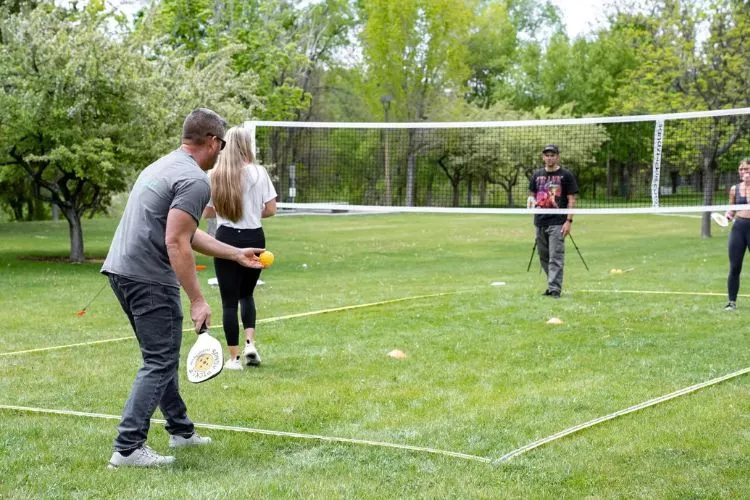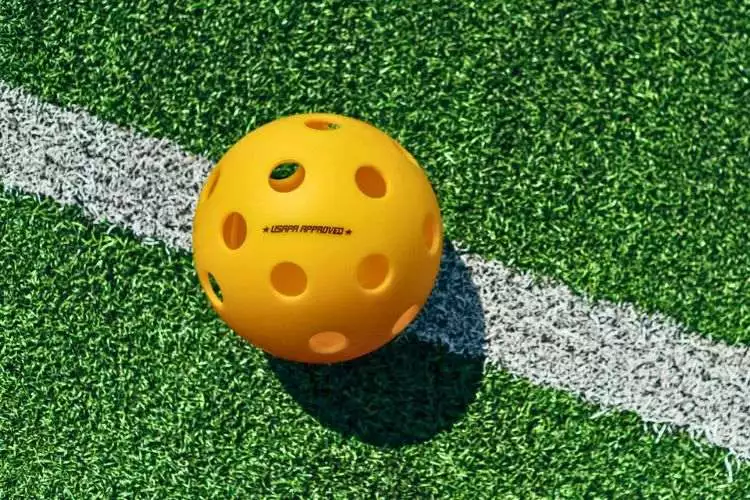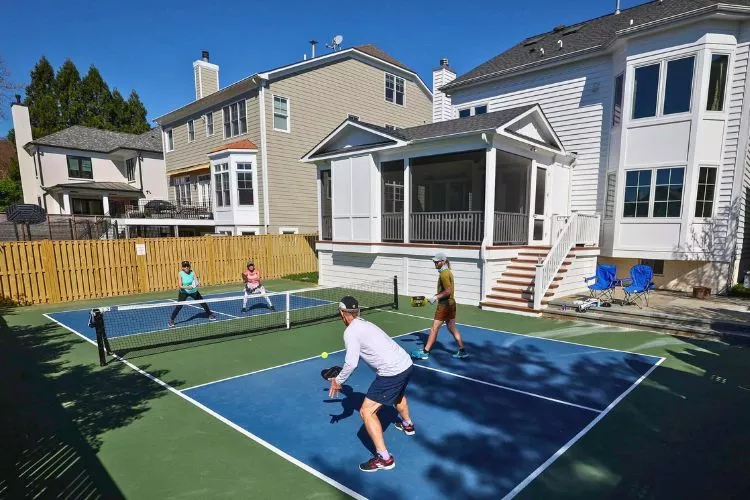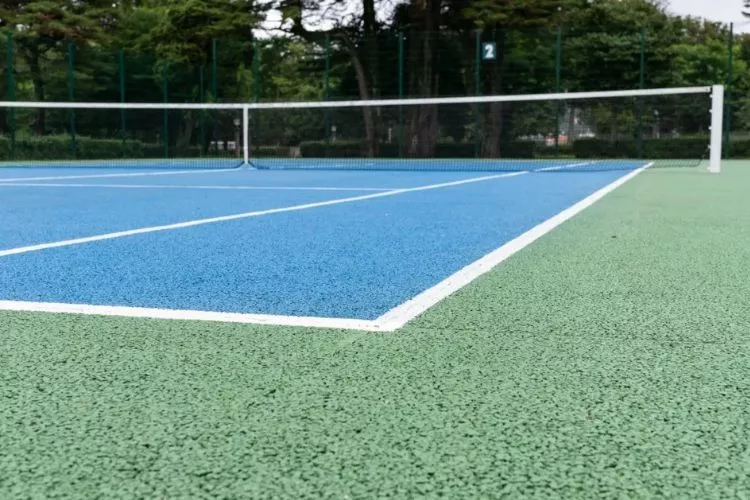Pickleball, a fast-growing sport that combines elements from tennis, badminton, and ping-pong, is usually played on solid surfaces such as indoor gym floors or outdoor tennis courts.
But, can you play pickleball on grass? I mean can you enjoy this exciting game on the soft, lush terrain of a grassy field?
In this article, we dive into the feasibility of playing pickleball on grass, discussing the pros and cons, the impact on gameplay, and sharing some helpful adaptations for those eager to give it a try.

Can you play pickleball on grass?
You can play pickleball on grass just like any other sport. However, it’s not typically recommended or practiced widely due to a few considerations.
First, the ball used in pickleball doesn’t bounce as efficiently on grass as it does on a hard surface such as a conventional pickleball court. This could affect the rhythm and speed of the game.
Secondly, the grassy surface can be uneven, potentially leading to unpredictable ball movements and slips or trips for players.
Despite these challenges, if you’re eager to play pickleball on grass, you can!
Modifying the game rules slightly and investing in softer balls designed to bounce better on grass can increase the playability. Please remember to check the field for any potential trip hazards before playing to maintain safety.
Can a pickleball bounce on grass?
Yes, a pickleball can bounce on grass, albeit with reduced bounce height and responsiveness.
The nature of the grassy surface dampens the bounce compared to harder surfaces such as indoor gym floors or outdoor tennis courts.

Consequently, this may impact the gameplay and overall pickleball experience. To improve the game’s playability on grass, try using specific pickleballs designed for better bounce on softer surfaces or adjust the game rules to account for the reduced bounce.
Do you have to have a hard surface to play pickleball?
While pickleball is typically played on a hard surface (e.g., concrete, asphalt, or a gym floor), it’s not strictly required for a casual game.
However, hard surfaces provide a more consistent bounce for the ball and predictable gameplay, making the experience better aligned with the sport’s traditional standards.
Playing on a soft surface like grass introduces unique challenges, such as an uneven playing field and reduced ball bounce.
For those interested in playing pickleball on grass for recreational purposes, it is still possible with some adjustments to the game rules and using equipment specifically designed to perform better on grass.
How do you make a pickleball court in your backyard?
Follow these steps to create your own pickleball court:

Step 1: Choose the Right Area
Select a smooth, level area in your backyard that can accommodate a court measuring 20 feet by 44 feet for doubles (or 20 feet by 34 feet for singles). Ensure it’s free from any obstructions like trees or garden structures.
Step 2: Prepare the Ground
Clear the selected area of debris, stones, and vegetation. If the ground is uneven, you might need to level it. You could do this yourself with some basic tools, or hire a professional.
Step 3. Measure and Mark the Court
Measure and mark out the court dimensions using stakes and string. The outlines include the sidelines, baselines, non-volley zone lines (7 feet from the net on both sides), and service lines (halfway between the non-volley zone and the baseline).
Step 4: Construct the Base
Lay a base layer of gravel or crushed rock for water drainage and to provide a solid foundation. The thickness can vary based on the type of finish you choose. Overlay this with a layer of finer gravel or sand for leveling perfection.
Step 5: Surface the Court
Here you can choose between several options: asphalt, concrete, or even a synthetic outdoor surface for professional standards. For a more budget-friendly option, consider compacted crushed stone or gravel. After surfacing, paint the court lines to make them clearly visible.
Step 6: Install the Net
The net should be installed in the middle of the court (22 feet from each baseline for a doubles court). It should be 36 inches high at the edges and 34 inches high in the center.
Step 7: Finishing Touches
You may want to install a fence around the court to prevent balls from going out of play. Having some form of outdoor lighting would also be beneficial for evening games.
Remember to check with your local municipality or homeowners’ association to ensure that constructing a pickleball court in your backyard complies with any local zoning or building codes. If you’re unsure about any steps, consider hiring a professional to assist.
What is the cheapest way to make a pickleball court?
The cheapest way to make a pickleball court is by creating a makeshift court with minimal alterations to your existing backyard or driveway. Here’s how:
- Choose a flat and evenly leveled area that can accommodate the court dimensions (20 feet by 44 feet for doubles or 20 feet by 34 feet for singles). A driveway or a grassy patch can work.
- Use easily removable materials like chalk or field paint to mark out the court outlines, including sidelines, baselines, non-volley zone lines, and service lines.
- Instead of installing a permanent net system, opt for a portable one or improvise by using poles or other existing vertical supports with a rope or string tied across to represent the net.
- Use standard pickleball equipment like paddles and balls to complete the setup.
Keep in mind that while this option is the most economical, it may not provide the same playing experience as a professionally constructed court with a proper surface and fixtures. However, it’s suitable for casual play and practice.
Can You Play Pickleball on an Artificial Turf?
Playing pickleball on artificial turf is indeed possible, but it can come with its own set of challenges.
Artificial turf doesn’t provide the smooth, hard surface typically associated with traditional pickleball courts, which can result in decreased ball bounce and unpredictable ball movement.

Furthermore, the slightly softer surface of artificial turf compared to hard courts may affect players’ footing and make movements more strenuous.
To mitigate these issues, you might want to consider using pickleballs designed for better bounce on softer surfaces and wearing appropriate footwear for better grip on turf.
How to Play Pickleball Without a Court?
Playing pickleball without a traditional court can be possible with some creativity and flexibility in terms of equipment and rules. Here’s how:
- Define Your Space: Choose a flat area like a patio, driveway, or lawn and mark your own makeshift court using chalk or tape. Ensure that the area is free from obstacles that could interfere with gameplay or cause injuries.
- Net Setup: If you don’t have a conventional pickleball net, improvise by using any type of barrier that can replicate a net, such as a piece of rope, garden trellis, or even a clothesline strung up between two posts. The net should ideally be about 36 inches high at the sidelines and 34 inches in the center.
- Equipment: Standard pickleball paddles and balls should be used, but in a pinch, similar paddle and ball sports equipment could be substituted.
- Adjust Rules: The basic rules of pickleball can stay the same, but you might need to tweak specific ones depending on your setup, especially regarding ball bounces and service rules.
Remember, the primary goal is to have fun and enjoy the sport, even if your setup isn’t a traditional pickleball court.
Conclusion:
Playing pickleball on grass certainly presents unique challenges, including reduced ball bounce, unpredictable ball pathways, and potential tripping hazards.
However, with some modifications to standard game rules and equipment adaptations, it’s entirely feasible and can bring new dimensions to your pickleball experience.
Likewise, unconventional settings such as artificial turf, driveways, or makeshift backyard courts also offer alternative platforms for enjoying this engaging sport outside of the traditional hard court.
It’s important to remember that whether it’s played on a purpose-built court or a patch of lawn, the spirit of pickleball — fostering health, activity, competition, and camaraderie — remains unaltered.

Pickleball’s more than a game to me—it’s a passion. I write, sharing its highs and lows, the thrills and the lessons. Some tales might draw you to the court, while others give a hint of the game’s magic. So, curious about my journey? Ready to dive deep into the world of pickleball with me? Let’s go.
